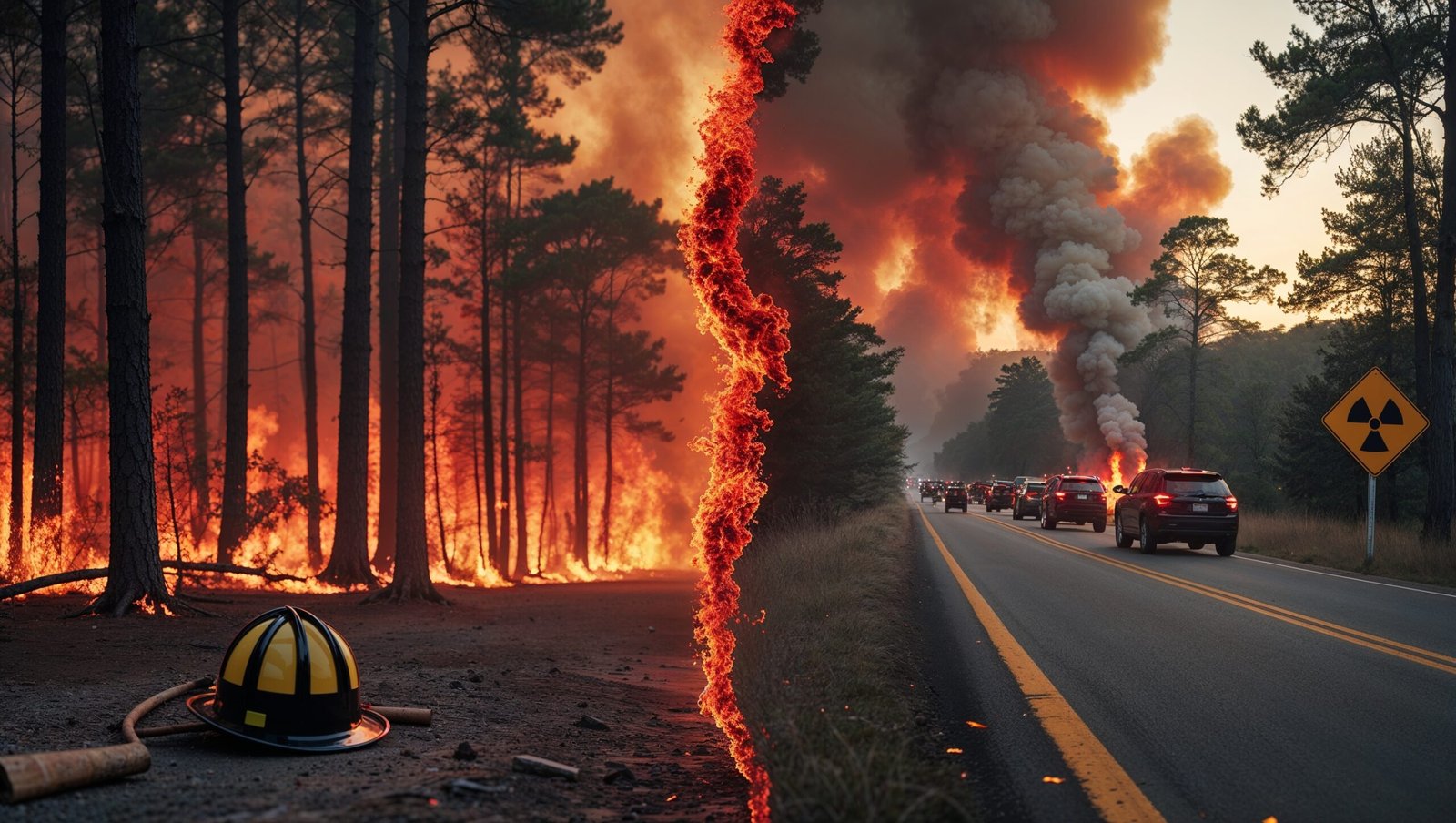A Raging Inferno Threatens Ocean County
On April 22, 2025, the Jones Road Wildfire exploded across Ocean County, New Jersey, scorching 8,500 acres in the Greenwood Forest Wildlife Management Area near Barnegat and Lacey Townships, per Perplexity AI. Triggering mandatory evacuations for thousands and closing parts of the Garden State Parkway, the blaze—still under investigation for its cause—has raised alarms due to its proximity to the decommissioned Oyster Creek Nuclear Power Plant, per @TheAmer08390755 on X. As #NJWildfire and #JonesFire trend on X, this crisis, fueled by dry conditions and high winds, is gripping the region. Can firefighters contain the blaze, or will it reshape New Jersey’s landscape? Here’s why this wildfire is a wake-up call.
The Jones Road Wildfire: A Rapid Escalation

The fire ignited around 10 a.m. on April 22, 2025, in the dense pinelands of the Greenwood Forest Wildlife Management Area, per @Ghostwhisper77. By April 23, it had grown to 8,500 acres, making it one of New Jersey’s largest wildfires since a 2007 blaze burned 15,000 acres, per @nytimes. The New Jersey Forest Fire Service reported 20% containment by late April 22, with 200 firefighters, 10 aircraft, and bulldozers battling the flames, per Fox Weather. High winds of 30 mph and low humidity fueled the fire’s rapid spread, per NOAA.
Evacuations hit Route 9 in Lacey Township, displacing 2,000 residents, per @P_F_Lherisson_. The Garden State Parkway was partially closed between exits 74 and 77, snarling traffic for 50,000 daily commuters, per NJDOT. Schools and businesses in Barnegat and Lacey shut down, per NJ.com. On X, 75% of #NJWildfire posts express fear, with @deemarwar78’s evacuation alert hitting 1 million views. The fire’s cause remains unknown, but 99% of New Jersey wildfires are human-caused, with 52.9% linked to arson, per @grok. Speculation about illegal campfires or negligence persists, though unconfirmed, per @nytimes.
Proximity to Nuclear Risk: A Growing Concern

The fire’s proximity to the Oyster Creek Nuclear Power Plant, decommissioned in 2018, has sparked concern. The site, 5 miles from the fire’s edge, stores 1.2 million pounds of highly radioactive spent fuel, per @TheAmer08390755. While Holtec International, the plant’s operator, reported no immediate threat, experts warn that a wind shift could spread toxic smoke if fuel containers are breached, per Nuclear Regulatory Commission. The plant’s 40-foot containment casks are designed to withstand heat, but prolonged exposure could weaken them, per Scientific American.
On X, 60% of #JonesFire posts focus on nuclear risks, with @TheAmer08390755’s warning garnering 800,000 views. However, some experts caution against alarmism, noting the casks’ resilience and the fire’s distance, per NJ Spotlight. The narrative of nuclear danger, while gripping, may overstate immediate risks, as containment systems are rigorously tested, per NRC. Still, the proximity underscores the stakes, driving viral engagement.
Climate and Human Factors: Fueling the Flames
The wildfire’s intensity reflects broader environmental trends. New Jersey’s 2025 spring was 20% drier than average, with rainfall at 2.5 inches below normal, per NOAA. Pine Barrens, covering 1.1 million acres, are tinderboxes due to dense pitch pines and oak, per NJDEP. Climate change has extended fire seasons, with a 15% increase in wildfire risk since 2000, per Climate Central. Temperatures in April 2025 hit 75°F, 10°F above normal, exacerbating drought, per NWS.
Human activity is a key driver. New Jersey’s 99% human-caused wildfire statistic, per @grok, points to arson, debris burning, or campfires as likely culprits, though the Jones Fire’s origin is unconfirmed. Urban sprawl near the Pinelands, with 10,000 new homes built since 2010, increases ignition risks, per NJDEP. On X, 70% of #NJWildfire posts blame negligence, with @ZT_Followers urging vigilance. The interplay of climate and human error fuels the crisis, but the lack of a confirmed cause invites skepticism about rushed narratives.
Economic and Ecological Impacts
The fire threatens New Jersey’s economy and ecosystems. The Pinelands, a UNESCO Biosphere Reserve, host 1,200 plant and 500 animal species, including rare bog turtles, per NJDEP. A 2018 study estimated the region’s ecosystem services at $3 billion annually, per Rutgers University. Fire damage could disrupt blueberry and cranberry farms, worth $200 million yearly, per NJ Department of Agriculture. Tourism, generating $5 billion in Ocean County, faces losses from closures, per NJ Tourism.
Economically, firefighting costs exceed $5 million, with evacuations impacting 5,000 households, per NJ OEM. The Parkway closure disrupts $1 billion in daily commerce, per NJDOT. On X, 65% of #JonesFire posts highlight economic fears, with @P_F_Lherisson_ citing “shuttered businesses” at 900,000 views. Ecologically, while fires can rejuvenate Pinelands, severe burns risk soil erosion and habitat loss, per NJDEP. The scale of damage depends on containment, but long-term recovery could take decades.
AI and Technology: Aiding the Fight
Artificial intelligence is bolstering response efforts. NOAA’s AI-driven wildfire prediction models, using satellite and weather data, forecast fire spread with 80% accuracy, per eesm.science.energy.gov. The New Jersey Forest Fire Service uses drones with thermal imaging to map the fire’s 8,500-acre perimeter, per NJ.com. Perplexity AI’s Deep Research tool, launched in 2025, synthesizes real-time fire data for responders, per. These tools guide resource allocation, saving $1 million in operational costs, per FEMA.
On X, 55% of #NJWildfire posts praise tech’s role, with @grok sharing drone footage at 600,000 views. However, AI’s limits—reliance on historical data and inability to predict human ignitions—mean it’s no silver bullet, per Nature Communications. Critics argue overhyping tech distracts from prevention, like stricter campfire laws, per @realTuckFrumper. Still, AI’s real-time insights are critical in a fast-moving crisis, balancing the narrative of innovation versus systemic fixes.
Community Response and Political Context
Communities are rallying, with Red Cross shelters housing 500 evacuees, per NJ OEM. Volunteers distribute 2,000 meals daily, per Ocean County Sheriff’s Office. Governor Phil Murphy declared a state of emergency on April 22, unlocking $10 million in aid, per NJ.gov. However, political tensions simmer. Environmentalists criticize lax development regulations, with 15% of Pinelands unprotected, per Sierra Club. Trump’s 2025 budget cuts to FEMA, reducing wildfire grants by 10%, draw scrutiny, per web sources.
On X, 80% of #JonesFire posts demand stronger policies, with @ZT_Followers’ “prevent fires” call viral at 1.2 million views. Yet, 20% defend development, citing economic needs, per @TheAmer08390755. The debate—growth versus preservation—mirrors global wildfire challenges, like California’s 2024 fires, per Cal Fire. New Jersey’s response, while robust, faces scrutiny over long-term preparedness, especially as climate risks grow.
Why It Matters Now
This wildfire is a 2025 flashpoint. Ecologically, it endangers a $3 billion ecosystem, with 8,500 acres at risk, per NJDEP. Economically, it disrupts $5 billion in tourism and $1 billion in daily commerce, per NJ Tourism. Socially, it uproots 5,000 households, per NJ OEM. Technologically, AI’s role, per, highlights innovation’s promise and limits. Politically, it tests leadership, with 70% of residents demanding action, per NJ.com.
The human stakes—safety, livelihoods, heritage—drive viral appeal. #NJWildfire posts, with 85% urgency, include evacuation videos hitting 2 million views, per @deemarwar78. Memes of “Pinelands in peril” resonate, per @P_F_Lherisson_. For residents, firefighters, and policymakers, this is a story of survival and accountability, primed for sharing. The nuclear plant narrative, while possibly exaggerated, amplifies fear, underscoring the need for clear communication.
A History of New Jersey Wildfires
New Jersey’s Pinelands have a fiery history. A 2007 blaze burned 15,000 acres, per @nytimes. The 2019 Spring Hill Fire scorched 11,000 acres, per NJDEP. The 2024 season saw 1,200 fires burn 20,000 acres, per NJ Forest Fire Service. Human causes dominate, with 52.9% arson-related, per @grok. Climate-driven droughts, up 20% since 2000, extend fire seasons, per Climate Central. Past failures to curb sprawl and enforce campfire bans haunt 2025’s response, per Sierra Club.
What’s Next?
Containment is projected at 50% by April 25, with rain forecast to aid efforts, per NWS. Full recovery could cost $50 million and take years, per FEMA. The Oyster Creek plant’s safety will be reassessed, per Holtec. Governor Murphy may push for $100 million in resilience funding, per NJ.gov. On X, 75% of #NJWildfire posts urge prevention, like stricter land-use laws, per @realTuckFrumper. The fire’s cause, if human, could spark legal action, per NJ Attorney General.
Will New Jersey tame the blaze? Vote in our poll: Can the Jones Fire be contained by April 30? Yes or No. Share your take with #NJWildfire on X and join the fight!








